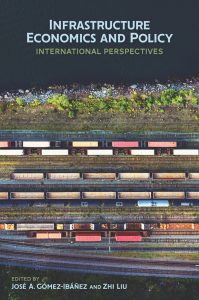
Target: Greater returns on public investments
By Adam Freill
ConstructionNew book examines long-term economic impact of infrastructure investments.
At a time when governments are considering infrastructure as a policy instrument to stimulate national economies that have been adversely affected by the COVID-19 pandemic, the Lincoln Institute has published a book aimed at helping policy makers achieve a greater return on public investments.
Edited by José Gómez-Ibáñez and Zhi Liu, Infrastructure Economics and Policy: International Perspectives presents insights from 30 leading international academics and practitioners on such topics as project appraisal, financing, governance, climate change and technology.
The book offers case studies, data and analyses that can help governments evaluate infrastructure proposals. It proposes six considerations for any infrastructure investment package.
Think long-term growth, not quick stimulus
Contrary to conventional wisdom, infrastructure investment is not an effective way to provide a quick economic stimulus. It takes many years to secure the permissions and funding necessary to begin construction on a new project, and the sophisticated equipment and training required by modern construction means such projects do not offer pathways to quick employment for large numbers of unskilled workers.
Infrastructure investments offer few short-term impacts, even when the long-term economic impacts are clearly positive.
Shovel-worthy matters, not shovel-ready
The impact of infrastructure projects depends greatly on their quality. Many infrastructure agencies are required to prepare cost-benefit analyses of the major projects or policies they are considering, and of the relevant alternatives to those projects.
Few, if any, governments require agencies to adopt the alternative with the highest net benefit. This is often because of political considerations, including concerns that cost-benefit analysis might not adequately reflect the goals of fairness and equity.
While cost-benefit analyses are not perfect, they are one of the best tools available for evaluating infrastructure proposals, and agencies should be cautious about departing significantly from the option with the highest net benefit without good reason.
Beware of over-confidence and over-optimism
A landmark analysis of some 2,000 infrastructure projects found that actual costs were significantly higher than forecast, while usage was significantly lower, as Bent Flyvbjerg and Dirk W. Bester explore in a chapter of the book.
The authors identify several well-known behavioral limitations that lead to these outcomes, particularly overconfidence bias and optimism bias. Fighting these biases is difficult because they are so deeply ingrained in human nature, but the book describes measures that can help, such as holding forecasters legally accountable or using independent audits.
Take equity seriously
The costs and benefits of infrastructure projects are often distributed inequitably. On the one hand, major infrastructure facilities, such as highways and power plants, are often built in locations where the negative impacts are felt disproportionately by low-income residents.
On the other hand, the lack of access to basic infrastructure, particularly in the developing world, impairs quality of life and contributes to inequality.
Governments need to take both problems seriously and enact complementary policies to address them.
Consider governance challenges
State and local governments have historically been deeply involved in regulating both private and government-owned infrastructure due to important concerns including access, siting and protecting against monopolization.
The advent of a major new infrastructure program — particularly one focused on decarbonizing the energy system to address climate change — will increase the role of the national government. National governments are uniquely positioned to invest in new technologies that require collective action, and to mitigate the economic impact of climate change policies, for example, compensating owners of fossil fuel plants and other assets that lose their value.
These and other governance challenges related to infrastructure may prove even more difficult than the financial challenges that current debates focus on.
Invest for the future and address radical uncertainties
In the face of radical uncertainties, including climate change, the pandemic, automation and the emerging sharing economy, governments must not only fix deteriorating infrastructure, but also invest in a new generation of infrastructure that is climate-resilient and takes advantage of new technologies.
This transformation will require overcoming significant institutional barriers, assessing the pros and cons of the new technologies, and putting an effective change management process in place.





